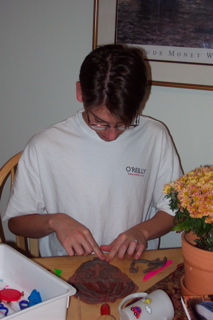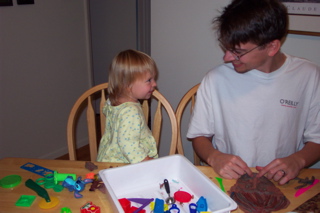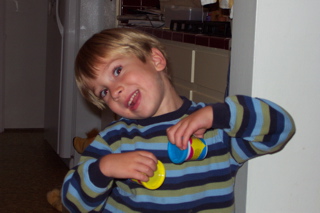Podcast. Selah.
This is an experiment.
The audio sucks because I did it with the built-in microphone on my laptop.
This is an experiment.
The audio sucks because I did it with the built-in microphone on my laptop.
This is a random idea. I would like to model the Getting Things Done workflow process in XSLT, if for no other better reason than to wrap my brain around it. I would model various “inbox” items as XML elements and then string them together in different orders inside sample documents. Then I would set up my rule set, encoded as XSLT template rules. There would be a corresponding XML vocabulary to the various decisions (“Do it”, “Delegate it”, “Defer it”) and to the various buckets (“Next Actions”, “Waiting”, “Calendar”, etc.). The incoming events would be processed according to the template rules, and the result would reflect the decisions made and the resulting state of the system as it responds to the events.
The next step would be to set up an overall loop somehow and allow the system state to evolve over time as new events come in.
I liked this excerpt from pg. 107:
…I know how unpleasant it is to know what you want to do but not know how to do it.
I’ve been in that place again and again in my life whenever I’ve wanted to step out of what’s already been done and create something original, be it a work of art or a life that works for me. Recently, for example, I decided to create a line of greeting cards. Having done virtually no previous art projects since sixth grade when art disappeared from the public school curriculum, I thought my card creations would simply spring forth from my inspiration. I had great ideas, glorious ideas, for my cards. If only you could see them as they existed in my head! But I had no idea how little paper and scissors and glue know about what I have in mind. Or how stubborn and uncooperative they and all manner of matter can be.
When I sat down to execute my creative ideas, I was shocked at the quandaries I faced. To name just a few: Where do you find gold pinecones? How do you attach them to a card? Why does the glue stick everywhere except where you want it to? How do you keep it from showing through as streaks underneath the foil? Why does the glitter insist on falling off and why did I think that a pinecone of any size would fit inside an envelope? . . . and on and on and on. “Uh-oh! I didn’t think of that!” became my mantra.
There is usually an inverse proportion between how much something is on your mind and how much it’s getting done.
My morning writing times have begun to bear witness to that. The time comes every day. I don’t have to make it happen. I can trust that it will come and that progress will be made. And I don’t think about it at all through the rest of my day! It is not looming over my head and it does not add any stress to my life.
If the above quote is true in general, just think of the possibilities that uncluttering your mind could bring.

If You Want to Write: A Book about Art, Independence and Spirit by Brenda Ueland.
I found this gem on a bookshelf at my cousin’s house. It is definitely worth reading and re-reading. I am half way through it, but I intend to read it many more times. Written in 1938.
It’s not just about writing, but about creativity and the attitude towards life that fosters creativity and even worship (as I interpret the book). It is chock full of truth and inspiration and recitable’s.
Here’s a nice one I shared with my writing team:
I learned that you should feel when writing, not like Lord Byron on a mountain top, but like a child stringing beads in kindergarten,–happy, absorbed and quietly putting one bead on after another.
Living with ADD is like going 100mph on an icy road with no guardrails.
I run in the path of your commands, for you have set my heart free.
Structure in which to flow.
Meta-No :
We demolish arguments and every pretension that sets itself up against the knowledge of God…
And Meta-Yes:
…and we take captive every thought to make it obedient to Christ.
And another example juxtaposition:
Flee the evil desires of youth and pursue righteousness, faith, love, and peace, along with those who call on the Lord out of a pure heart.
The promises of God brought to bear on my reticular activating system. I have begun training. Training for godliness. I’m hard at work on my mental network of promises, laws, statutes, precepts, commands. Structure in which to flow.
The law of the Lord is perfect, reviving the soul.
The statutes of the Lord are trustworthy, making wise the simple.
The precepts of the Lord are right, giving joy to the heart.
The commands of the Lord are radiant, giving light to the eyes.
The fear of the Lord is pure, enduring forever.
The ordinances of the Lord are sure, and altogether righteous.

If something doesn’t work, don’t keep trying it. Try something else.
As always, “feedback rather than failure”.
Use wide-range movements (wider than you might think at first). You need to overstep the bounds before you can know where the bounds are. Exaggeration is better than understatement; too much movement is better than too little movement.
Persist. Be willing to “start over”. You’ve had a lot of feedback, so it’s not really that you’re starting over. You’re making progress, trying new things, moving beyond things that don’t work. You’re adding to your repertoire of tricks. Be open to learning. You are changing and growing.

Related insights from Gadamer:
In the last analysis, is it not an illusion to think that we can separate play from seriousness and only admit it to segregated areas peripheral to real life, like our leisure time which comes to resemble a relic of lost freedom? Play and seriousness, the exuberance and superabundance of life, on the one hand, and the tense power of vital energy on the other, are profoundly interwoven. They interact with one another, and those who have looked deeply into human nature have recognized that our capacity for play is an expression of the highest seriousness. For we read in Nietzsche, “Mature manhood: that means to have found again the seriousness one had as a child–in play.” Nietzsche also knew the reverse of this as well, and celebrated the creative power of life–and of art–in the divine ease of play.
